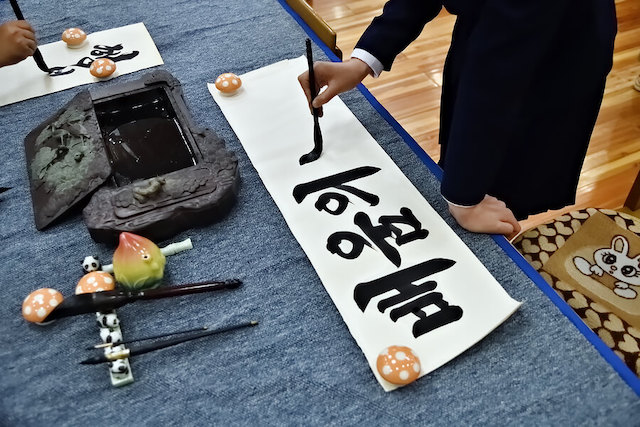One of the exciting things about learning a new language is also to learn about its culture and history. In Korea, one unique heritage art form that is well known is its calligraphy.
Calligraphy is a distinctive art form in East Asian cultures like Japan and Korea, with heavy influences from Chinese calligraphy. And this is understandably so, as Japan and Korea both borrowed Chinese characters for their own languages. As Japanese and Korean developed their own scripts, their styles of calligraphy also morphed into unique forms, with their own distinguishing factors.
Think calligraphy means old, traditional, forms of brush writing? Not anymore! With the rise of modern calligraphers, Korean calligraphy is an up-and-coming art form, and well valued amongst designers and artists. To understand a bit more about the artistry behind Korean calligraphy, let’s explore some facts about it below!
1. The Four Friends of the Study
In Korean, there is something called munbangsa’u, which literally means ‘Four Friends of the Study’. They refer to the essential materials needed for calligraphy, which include the brush, ink, paper, and inkstone. These must-haves stem from Chinese calligraphy, which terms these four elements ‘Four Treasures of the Study’.
Great importance is placed on these 4 elements, because they directly affect the result of the calligraphy. Brush size, paper material, ink thickness, and more all have significant bearings on the resulting texture and flow of the final product. Of course, the calligrapher’s skill and technique also play a role, with different effects achieved by adjusting angle, pressure, direction, rhythm, and stroke order.
2. 5 major types of Korean calligraphy
In much of the same way Latin alphabet fonts are categorised into serif, sans serif, scripts, and more, there are also ways to classify the varied styles of Korean calligraphy. Mainly, 5 major types exist. They can be described as follows:
- Jeonseo (전서): Meaning ‘seal script’, this style takes on the features of ancient Chinese scripts, which is more hieroglyphic and picture-like. Typically, they are carved or written in a monoline fashion.
- Choseo (초서): This is a style of cursive script that features loosely-connected strokes and fluid lines. To the uninitiated, Choseo can look messy and illegible, but the sense of movement and character is what makes this style so charming.
- Haeseo (해서): Haeseo, or ‘block script’, is like the serif equivalent in Korean calligraphy. Reserved for formal use, it uses controlled strokes to produce very regular, almost type-written words.
- Haengseo (행서): This semi-cursive script style is an in-between of Choseo and Haeseo, featuring connected strokes to produce text that is, for the most part, still well legible.
- Yeseo (예서): Dubbed the ‘official script’ or ‘clerical script’, Yeseo is a utilitarian style with clean, balanced lines of varying widths for optimising readability on ancient official documents.
3. Korean calligraphy’s defining features
Although a large part of Korean calligraphy was influenced by Chinese calligraphers, it has evolved today to have some unique features of its own. For one, Korean calligraphy is no longer limited to the use of Chinese characters, known as 한자 (hanja). Since the invention of the hangeul alphabet, Korean calligraphers have begun developing styles using 한글 (hangeul).
Hangeul gives a vastly different air to calligraphy because it contains, on average, fewer strokes. There are also unique stroke movements to consider – take for example, the circle, which Chinese characters don’t have. Thanks to the hangeul script, Korean calligraphy now has its own flavour and flair, which has earned itself ardent fans and practitioners alike.
With these 3 quick tidbits about Korean calligraphy, we’re sure you’ve gained some new insights into this unique Korean art form. If you are interested in picking up a new skill, you can even try your hands at it yourself! Who knows what beautiful works of art you can come up with?
Of course, learning Korean calligraphy would be made easier if you have some understanding of the language itself. You can enrol in a Korean language course to get yourself acquainted with Korean and learn more about its rich culture as well! Here at Sejong Korean Language School, we welcome learners of all skill levels to join us. Do note that we are conducting our classes online at the moment, so if you do decide to sign up, we’ll see you online!


